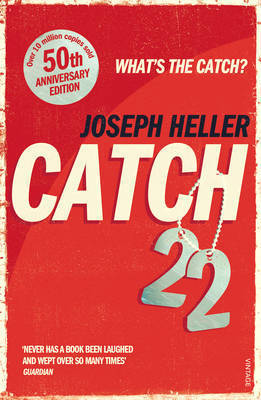Book Summary: Catch-22
Catch-22 is a revolutionary book by Joseph Heller which was first published in 1961. This book is a one of its kind. Heller uses a non-chronological third person omniscient narration to bind the threads together. Ideas flow into each other through random connections within the story. Events have been repeated through different point of views. The story is situated in the time of World War 2. This story is about the life of Captain John Yossarian, a U.S. Army Air Forces bombardier in 256th squadron who has been assigned to bomb enemy posts at eastern France and Italy.
The novel is set during World War II, from 1942 to 1944. It mainly follows the life of Captain John Yossarian, a U.S. Army Air Forces B-25 bombardier. Most of the events in the book occur while the fictional 256th Squadron is based on the island of Pianosa, in the Mediterranean Sea, west of Italy. The novel looks into the experiences of Yossarian and the other airmen in the camp, who attempt to maintain their sanity while fulfilling their service requirements so that they may return home.
Book Review: Catch-22
Never have I been pulled through the entire spectrum of emotion quite as enjoyably as this, with Joseph Heller ingeniously switching tones on a dime with a magician’s charm. One moment I was laughing like a fool, and the next I was clenching my jaw with agony at the horrors of the World War II; thankfully for my taste, Heller leaned more on the comedic/optimistic side.
Reading Catch-22 was sort of like watching a brilliantly shining coin flipping through a majestic parabola in slow motion, with one side representing laugh-out-loud comedy and the other an intense exploration of the terrors of war, making its way to the ground with the weight of someone’s fate resting on whichever side it falls on. But this isn’t just a thoughtless experiment. Both tones are equally pleasing and useful to the story. Catch-22 is really a life changing book that you should read at least once in a life time.
Catch-22 definitely wasn’t perfect, but it’s close. It reminded me of a Confederacy of Dunces because there were segments that I know a lot of people simply won’t laugh at if they don’t possess a certain sense of humor. And at times it can be a bit much to wrangle, but if you don’t allow the insanity and chaos to consume you, you’ll enjoy it thoroughly.
I feel that Yossarian and Dunbar have handled the situation–with a sane amount of insanity that’d be necessary in the face of such horror and idiocy. Yossarian has to be the best anti-hero I’ve come across so far, and the way Heller is able to spin illogical conversations, rules, and situations into logical nonsense and back again is fantastic.
I’m rambling now, but this is truly laugh out loud great. Among too many to name, Clevinger’s interrogation and the moaning at the briefing were comedic gold. But have no doubt that this is a “thinking person’s” book as well. It deals with all of the Big questions of life in some manner. There’s plenty of psychology to examine, be it bureaucratic, war, anxiety, etc.; and the final scene with Snowden was incredibly touching.
I really cannot say enough about this beauty, so trust me and see for yourself. This was my second attempt to read it after ditching it 30 pages in a year ago. And part of that was due to my having read all of the bashing reviews and avoiding it. But like beauty, it’s all in the eye of the beholder, so give it a chance. I’m glad I did. And I think Joseph Heller’s prose is underrated; there were some sentences there that simply knocked me out. I will definitely read Catch-22 again and recommend to friends. This one pulled me in so well that it’s one of the rare books that has genuinely made me wish characters were killed off painfully…
Notes:
- The phrase ‘Catch-22’ was later added in English language referring to a type of impossible logic puzzle sometimes called a double bind. According to this story unstable men do not have to fly aircrafts, but the fact that they can rationally decide for themselves and ask for waiver, proves that they are stable enough. The meaning of Catch-22 explained through below conversation in the book:
”You mean there’s a catch?”
“Sure there’s a catch, “ Doc Daneeka replied. “Catch-22. Anyone who wants to get out of combat duty isn’t really crazy.”
There was only one catch and that was Catch-22, which specified that a concern for one’s own safety in the face of dangers that were real and immediate was the process of a rational mind. Orr was crazy and could be grounded. All he had to do was ask; and as soon as he did, he would no longer be crazy and would have to fly more missions. Orr would be crazy to fly more missions and sane if he didn’t, but if he was sane he had to fly them. If he flew them he was crazy and didn’t have to; but if he didn’t want to he was sane and had to. Yossarian was moved very deeply by the absolute simplicity of this clause of Catch-22 and let out a respectful whistle.
“That’s some catch, that Catch-22,” He observed.
“It’s the best there is,” Doc Daneeka agreed.
- Catch-22 was originally entitled Catch-18, but the title was altered just before publication; another novel, Mila 18 by Leon Uris, had been recently released, and publisher feared readers would be confused.





